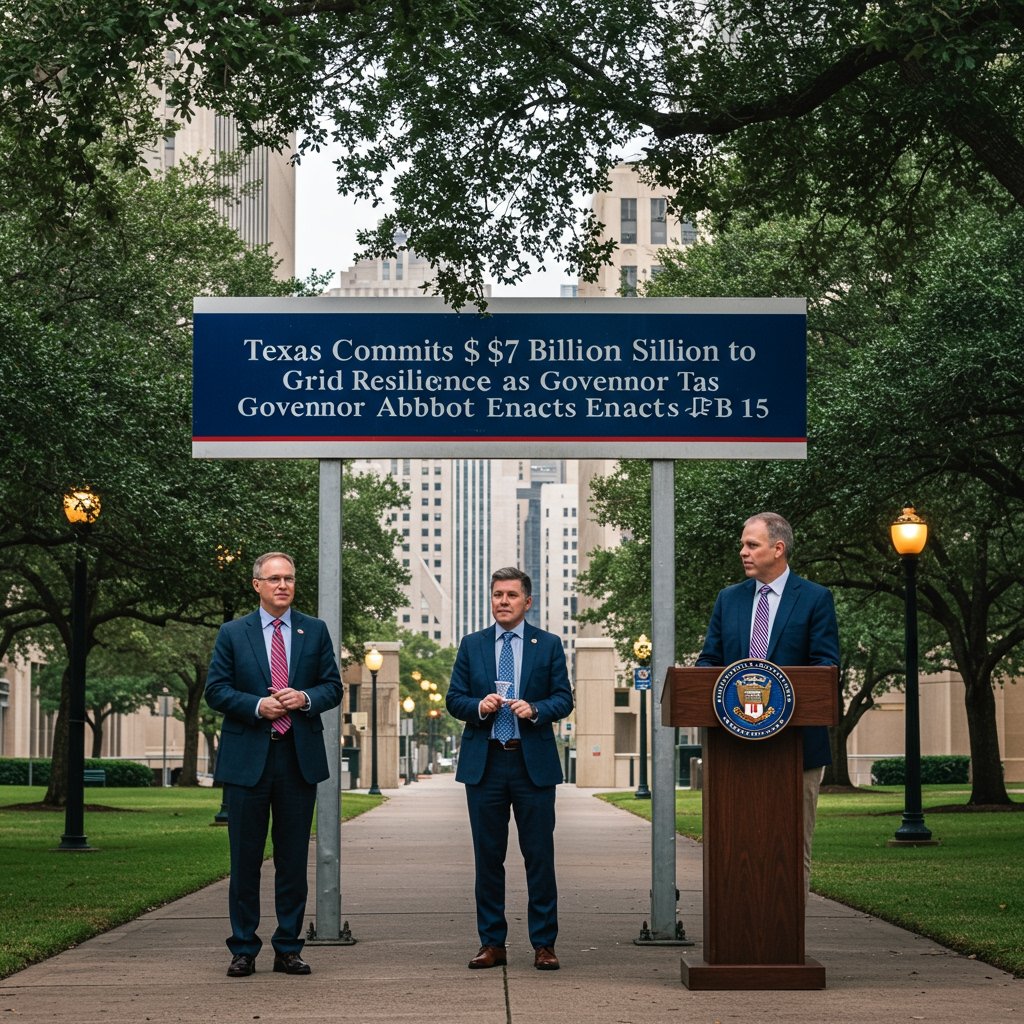AUSTIN, Texas – In a significant move aimed at bolstering the reliability and resilience of the state’s energy infrastructure, Governor Greg Abbott on May 9, 2025, officially signed Senate Bill 15 into law. The legislation, a culmination of extensive debate and legislative effort, establishes the Texas Grid Security Fund, earmarking a substantial $7 billion investment specifically for critical upgrades over the next five years. This landmark bill, set to take effect on September 1, 2025, introduces stringent new requirements for energy stakeholders across Texas.
A Landmark Investment in Energy Reliability
The signing ceremony marked a pivotal moment in Texas’ ongoing efforts to address the vulnerabilities highlighted by past extreme weather events that led to widespread and prolonged power outages. SB 15 represents the state government’s most ambitious financial commitment yet towards modernizing and hardening the power grid. The creation of the Texas Grid Security Fund provides a dedicated funding mechanism to support projects crucial for enhancing grid stability and preventing future failures. The $7 billion allocation over the next half-decade is intended to fund a range of initiatives designed to improve the grid’s capacity to withstand environmental stressors and meet peak demand under challenging conditions.
The fund’s establishment through SB 15 underscores a legislative consensus on the urgent need for significant investment. Lawmakers engaged in lengthy deliberations to craft a bill that balances the need for immediate action with a long-term strategy for grid security. The funding is expected to be disbursed for targeted improvements across the generation, transmission, and distribution sectors, prioritizing projects that deliver the most significant enhancements to overall grid reliability and resilience against severe weather.
Strengthening Infrastructure and Operations
A core component of Senate Bill 15 is the mandated critical infrastructure hardening. This includes requirements for power generation plants, transmission lines, and other key components of the energy delivery system to implement physical and operational upgrades necessary to withstand extreme weather. This could encompass measures such as weatherization of power plants, reinforcement of transmission towers, and burying critical distribution lines in vulnerable areas.
In addition to physical hardening, SB 15 places new, rigorous demands on the Electric Reliability Council of Texas (ERCOT), the state’s primary grid operator. The bill explicitly requires ERCOT to implement stricter operational standards for power generators and transmission utilities that operate within the Texas grid. These standards are expected to cover areas such as mandatory weatherization protocols, ensuring reliable fuel supplies for power plants during emergencies, enhancing communication protocols between grid operators and utilities, and enforcing performance requirements during peak demand or extreme weather events. The goal is to create a more robust and responsive system capable of maintaining stability even under duress.
Utilities and generators operating in the ERCOT market will be subject to new compliance requirements and potentially face penalties for failing to meet the elevated standards. The legislation aims to ensure that all actors within the energy ecosystem are prepared for and capable of operating reliably during challenging conditions, thereby reducing the risk and severity of future outages.
Addressing Past Challenges
The legislative impetus for SB 15 was significantly shaped by the experiences of Texans during past extreme weather events, which exposed critical weaknesses in the state’s power infrastructure and regulatory framework. The outages that occurred during these events resulted in significant economic disruption and hardship for millions of residents. SB 15 is a direct response to these challenges, reflecting a commitment from state leadership to learn from past incidents and implement necessary reforms.
The bill’s design, which includes both infrastructure investment through the Texas Grid Security Fund and enhanced regulatory oversight by ERCOT, represents a multi-faceted approach to addressing grid vulnerabilities. The $7 billion allocation is intended to provide the financial resources needed to undertake large-scale, capital-intensive projects that were previously difficult to fund. The stricter operational standards are designed to ensure that the system is managed more effectively and that market participants are held accountable for reliable performance, particularly when the grid is under stress.
The Texas Grid Security Fund: Allocation and Impact
The $7 billion allocated to the Texas Grid Security Fund over five years is expected to be strategically invested in projects deemed most critical for improving grid resilience. Potential uses of the fund include providing financial incentives for power generators to implement severe weatherization upgrades, funding transmission line improvements to prevent bottlenecks and enhance transfer capacity, supporting the development of backup power solutions for critical infrastructure, and investing in advanced grid monitoring and control technologies. The fund will be administered with the goal of achieving tangible improvements in grid performance and reliability metrics.
This significant financial commitment reflects the scale of the challenge and the importance placed on ensuring energy security for a growing state. The fund’s activities will be overseen to ensure transparency and accountability in how the money is spent, with a focus on achieving measurable outcomes in grid resilience.
Looking Ahead
With Governor Abbott’s signature on May 9, 2025, Senate Bill 15 is now set to become law, taking effect on September 1, 2025. The next phase will involve the detailed implementation of the bill’s provisions by state agencies, including ERCOT, and compliance efforts by power generators and transmission utilities. The creation of the Texas Grid Security Fund and the mandate for stricter standards represent a major policy shift aimed at preventing a recurrence of the widespread power outages experienced during past extreme weather events.
The $7 billion investment signifies a long-term commitment by the state of Texas to securing its energy future and ensuring a more reliable power supply for its residents and businesses. The success of SB 15 will ultimately be measured by the improved performance of the grid under stress and the increased confidence of Texans in the reliability of their energy supply.






